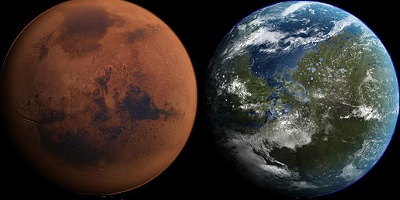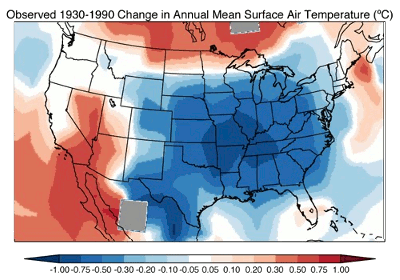Terraforming
May 11, 2012
Most fans of
science fiction will be familiar with
terraforming. As its name indicates, terraforming is an
hypothetical process of modifying a
planet to make it more like
Earth. Nowadays, the object might be to make it better than Earth. Terraforming usually means just modifying a planet's
atmosphere and
temperature to allow
Earth-like vegetation to take control in a
Gaia-sort of way.
The intended first target for such an effort has always been
Mars, which seems like the
easiest challenge among the planets of our own
Solar System.[1-4] The first order of business is to give Mars a little more
heat, so that its stores of
frozen carbon dioxide can increase the
atmospheric pressure. Once a
carbon dioxide greenhouse is set into motion, this process would be self-perpetuating.
Among methods proposed to heat Mars are blackening its surface to decrease its
albedo; and
asteroid impacts, which have a lot of
kinetic energy. The asteroids could also contain essential
compounds, such as
water. It's estimated that if all the frozen carbon dioxide on Mars were
sublimed into the atmosphere, the temperature of Mars would increase by about seventy degrees
Celsius, which would be above the
freezing point of water.[1]
There are
greenhouse gases more potent than carbon monoxide that would speed this process. I've reviewed these in a
recent article (The Methane Greenhouse, January 25, 2012) These are
methane (possibly imported from
Titan),
ammonia, and
fluorine compounds. As an extreme example,
sulfur hexafluoride (SF
6) has a greenhouse heating effect that's many thousands of times that of carbon dioxide. When atmospheric conditions are right, vegetation would be introduced to finish the terraforming process.

A terraformed Mars.
(Illustration by
Daein Ballard (edited), via Wikimedia Commons)
Unlike the
Genesis Project of the second Star Trek movie,
The Wrath of Khan, all this would happen over an extended period, possibly tens of thousands, or hundreds of thousands, of years. In the end, there would still be some problems, since Mar's lack of a
magnetic field would allow too much
radiation to impinge upon the surface.
Leaded underwear would be standard issue.
Since terraforming takes so much time and effort, you would think that it would be impossible to make a major impact on Earth's temperature in a short time. A recent
research collaboration of
scientists from many research institutions[5] shows that changing the average temperature of a portion of the Earth over a span of
decades is actually not that difficult.
Parts of the US have had global warming offset by the simple process of having more
particulates in the atmosphere, and
clean-air rules are now reversing that effect.[6-8] The research is reported in a two-part paper in the journal,
Atmospheric Chemistry and Physics.[7-8]
Particulate pollution over the
Eastern United States during the late
twentieth century created a cold patch that temporarily obscured the effects of
global warming.[6] Particulate matter in the air caused cooling by
reflecting sunlight back into
space. Now that
particulate pollution, especially
sulfates from
coal-fired power plants, has been controlled, the greenhouse warming in this region has begun to ramp up to the global trend. Sulfates were responsible for
acid rain.[6]
[6]

NASA Goddard Institute for Space Studies Surface Temperature Analysis for the period 1930-1990.
(Image by Eric Leibensperger, used with permission.))
The effect was localized because particulates remain in the atmosphere for a short time, on the order of a week. Although global mean temperature rose about 0.8 °C from 1906 to 2005, temperatures in this eastern "warming hole" decreased 1 °C from 1930-1990. The atmospheric particulate matter in that region peaked in 1980, and it's now been reduced by half. As a consequence, the cooling effect that's been counteracting global warming is now just 0.3 °C.[6]
Loretta J. Mickley, a Senior
Research Fellow in
atmospheric chemistry at
Harvard, and a coauthor of the study, says that the US data is a prelude to what might occur in
China.[6]
"Something similar could happen in China, which is just beginning to tighten up its pollution standards... China could see significant climate change due to declining levels of particulate pollutants... No one is suggesting that we should stop improving air quality, but it's important to understand the consequences. Clearing the air could lead to regional warming."
Quantitatively, the researchers found that
anthropogenic aerosols at their peak reduced ground heating power by two
watts per
square meter, most of this because of sulfates.[7] This caused a strong climate response by cooling the central and eastern US by 0.5 - 1.0 °C during 1970–1990. The strongest affect was on the maximum
daytime temperatures in
summer and
autumn.[8] The bulk of the cooling has been taken out of the atmosphere, and an additional warming of just 0.1 °C is projected.[8]
The research was supported by the
Electric Power Research Institute and the
U.S. Environmental Protection Agency.[6]
References:
- Terraforming Mars, NASA Web Site.
- Martyn J. Fogg, Tom Meyer, Stephen Gillett and Robert Haynes, "Planetary Engineering Bibliography," NASA, November 1995.
- M.J. Fogg, Terraforming Information Pages.
- Exploring Space, Mars Terraforming Timeline, Should We Terraform Mars?, PBS Web Site.
- The institutions involved in this study were the School of Engineering and Applied Sciences, Harvard University (Cambridge, MA), the Jet Propulsion Laboratory, California Institute of Technology (Pasadena, CA), the Division of Chemistry and Chemical Engineering, California Institute of Technology (Pasadena, CA), the School of Earth & Atmospheric Sciences and School of Chemical & Biological Engineering, Georgia Institute of Technology (Atlanta, GA), the Department of Civil & Environmental Engineering and Department of Engineering & Public Policy, Carnegie Mellon University (Pittsburgh, PA), Argonne National Laboratory (Argonne, IL), the Electric Power Research Institute (Palo Alto, CA), and the NASA Goddard Institute for Space Studies (New York, NY).
- Caroline Perry, "'Warming hole' delayed climate change over eastern United States," Harvard School of Engineering and Applied Sciences Press Release, April 26, 2012.
- E. M. Leibensperger, L. J Mickley, D. J. Jacob, W.-T. Chen, J. H. Seinfeld, A. Nenes, P. J. Adams, D. G. Streets, N. Kumar and D. Rind,"Climatic effects of 1950–2050 changes in US anthropogenic aerosols – Part 1: Aerosol trends and radiative forcing," Atmos. Chem. Phys., vol. 12 (2012), pp. 3333-3348.
- E. M. Leibensperger, L. J Mickley, D. J. Jacob, W.-T. Chen, J. H. Seinfeld, A. Nenes, P. J. Adams, D. G. Streets, N. Kumar and D. Rind,"Climatic effects of 1950–2050 changes in US anthropogenic aerosols – Part 2: Climate response," Atmos. Chem. Phys., vol. 12 (2012), pp. 3349-3362.
Permanent Link to this article
Linked Keywords: Science fiction; terraforming; hypothetical; planet; Earth; atmosphere; temperature; Earth-like vegetation; Gaia; Mars; terraforming of Mars; Solar System; heat; dry ice; frozen carbon dioxide; atmospheric pressure; carbon dioxide; greenhouse effect; albedo; asteroid impact; kinetic energy; chemical compound; water; sublimation; Celsius; melting point; freezing point; greenhouse gas; methane; Titan; ammonia; fluorine compound; sulfur hexafluoride; Daein Ballard; Wikimedia Commons; Genesis Project; The Wrath of Khan; Earth's magnetic field; ionizing radiation; Lead; research; scientist; decade; particulates; Clean Air Act; Atmospheric Chemistry and Physics; Eastern United States; twentieth century; global warming; reflection; sunlight; space; particulate pollution; sulfate; coal-fired power plants; acid rain; NASA Goddard Institute for Space Studies; Eric Leibensperger; Loretta J. Mickley; Research Fellow; atmospheric chemistry; Harvard; China; human impact on the environment; anthropogenic; aerosol; watt; square meter; daytime; summer; autumn; Electric Power Research Institute<; U.S. Environmental Protection Agency; School of Engineering and Applied Sciences, Harvard University (Cambridge, MA); Jet Propulsion Laboratory, California Institute of Technology (Pasadena, CA); Division of Chemistry and Chemical Engineering, California Institute of Technology (Pasadena, CA); School of Earth & Atmospheric Sciences and School of Chemical & Biological Engineering, Georgia Institute of Technology (Atlanta, GA); Department of Civil & Environmental Engineering and Department of Engineering & Public Policy, Carnegie Mellon University (Pittsburgh, PA); Argonne National Laboratory (Argonne, IL); NASA Goddard Institute for Space Studies (New York, NY).